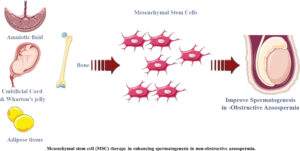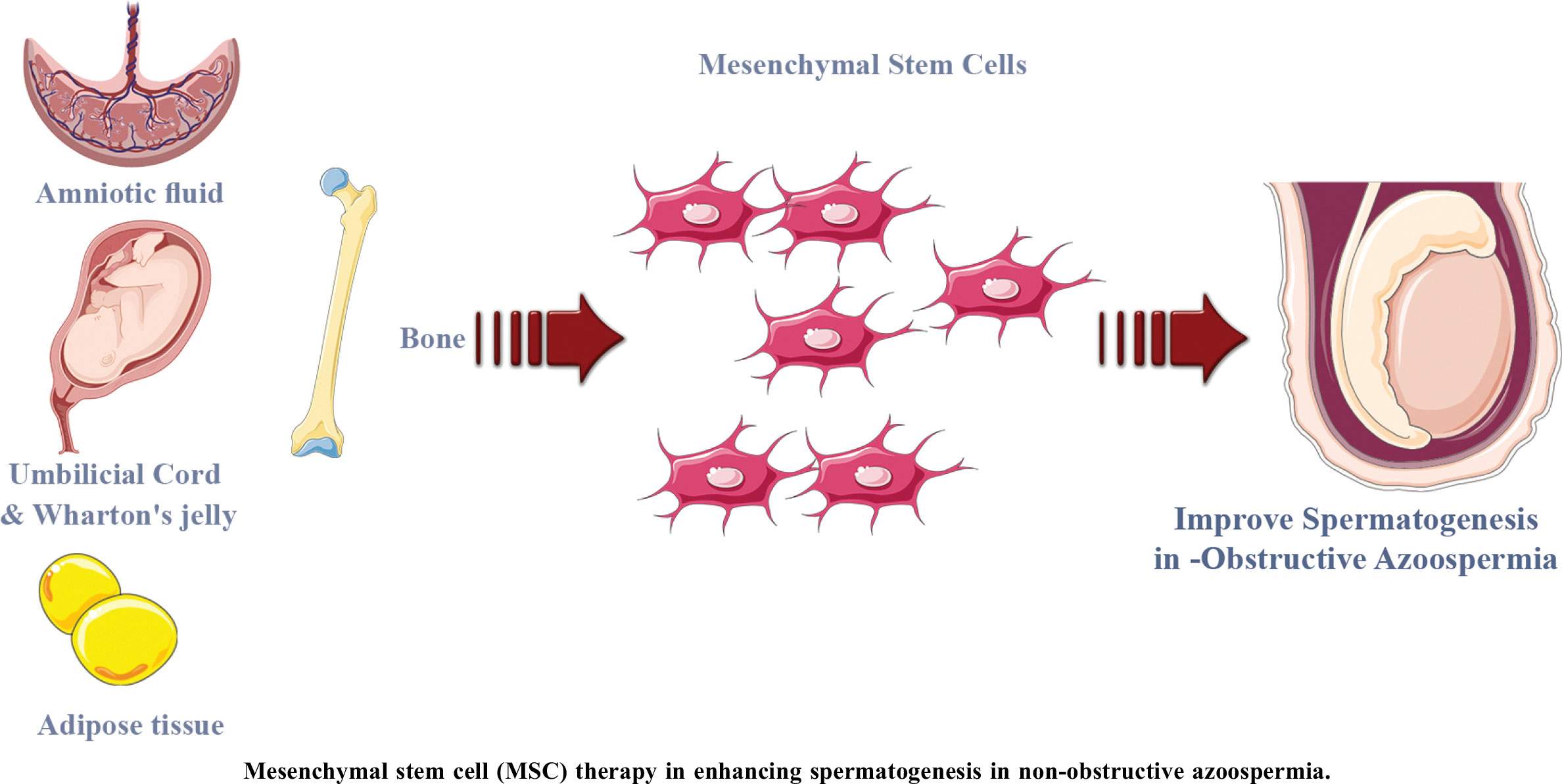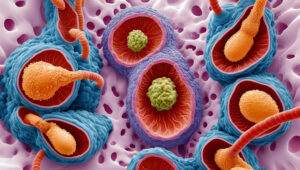The Potential of Mesenchymal Stem Cells in Treating Male Infertility and Non-Obstructive Azoospermia
Outline of the Article
- Introduction
- Overview of stem cells in regenerative medicine
- Importance of addressing male infertility
- Understanding Stem Cells
- What are stem cells?
- Key characteristics: self-renewal and differentiation
- Types of Stem Cells
- Embryonic stem cells
- Adult stem cells
- Induced pluripotent stem cells (iPSCs)
- Mesenchymal stem cells (MSCs)
- What Makes Mesenchymal Stem Cells Unique?
- Characteristics of MSCs
- Sources of MSCs
- Therapeutic properties
- Male Infertility: A Global Challenge
- Statistics on male infertility
- Causes of male infertility
- Focus on azoospermia and its subtypes
- Non-obstructive azoospermia (NOA)
- Definition and causes
- Current treatment limitations
- Role of MSCs in Regenerative Medicine
- Differentiation potential
- Ability to regenerate tissue
- MSCs in Treating Male Infertility
- Animal model studies
- Differentiation into germ cells
- Extracellular Vesicles and Their Role
- Understanding extracellular vesicles (EVs)
- MSC-derived EVs in promoting spermatogenesis
- Advancements in MSC Research
- Recent findings in animal studies
- Limitations and challenges in current research
- Barriers to Clinical Trials
- Ethical considerations
- Technical and logistical challenges
- Future Prospects of MSC Therapy
- Innovations in stem cell technologies
- Potential for personalized medicine
- The Path Ahead for MSC Therapy
- Need for robust clinical trials
- Regulatory framework for MSC therapies
- Conclusion
- Summary of key points
- Importance of further research
- FAQs
- What are mesenchymal stem cells?
- How do MSCs help in treating azoospermia?
- Are there any side effects of MSC therapy?
- What is the current status of clinical trials for MSC therapy in NOA?
- How soon can MSC therapies be available for male infertility treatment?
Introduction
Stem cells are transforming the landscape of regenerative medicine with their remarkable ability to self-renew and differentiate into various cell types. This unique property makes them invaluable for treating degenerative disorders and tissue damage. One of the most promising areas of stem cell application is in addressing male infertility, a pressing global health concern.
Male infertility affects around 8-12% of the global population, with azoospermia—a condition characterized by the absence of sperm in semen—being a significant contributor. Among the various causes of azoospermia, non-obstructive azoospermia (NOA) poses a complex challenge. Emerging research highlights the potential of mesenchymal stem cells (MSCs) in addressing this condition, paving the way for revolutionary treatment options.
Understanding Stem Cells
What Are Stem Cells?
Stem cells are undifferentiated cells capable of developing into specialized cell types. They play a crucial role in growth, development, and tissue repair.
Key Characteristics
- Self-Renewal: The ability to divide and produce identical cells over long periods.
- Differentiation: The potential to develop into various cell types, such as muscle, nerve, or blood cells.
Types of Stem Cells
- Embryonic Stem Cells: Derived from early embryos and can develop into any cell type.
- Adult Stem Cells: Found in tissues like bone marrow; limited differentiation potential.
- Induced Pluripotent Stem Cells (iPSCs): Adult cells reprogrammed to behave like embryonic stem cells.
- Mesenchymal Stem Cells (MSCs): Multipotent cells with unique regenerative properties.
What Makes Mesenchymal Stem Cells Unique?
Characteristics of MSCs
- Multipotent differentiation potential
- Anti-inflammatory and immunomodulatory properties
Sources of MSCs
- Bone marrow
- Adipose tissue
- Umbilical cord blood
Therapeutic Properties
- Promote tissue regeneration
- Enhance healing processes
- Secrete extracellular vesicles (EVs) with regenerative factors
Male Infertility: A Global Challenge
Male infertility impacts millions worldwide. While various factors contribute, azoospermia—a severe form of infertility—requires immediate attention. NOA, in particular, is caused by intrinsic testicular failure, making treatment exceptionally challenging.
Non-obstructive azoospermia (NOA)
Definition and Causes
NOA occurs when the testes fail to produce sperm due to genetic, hormonal, or environmental factors.
Current Treatment Limitations
- Hormonal therapies offer limited success.
- Surgical sperm retrieval has low efficacy.
Role of MSCs in Regenerative Medicine
MSCs are gaining traction for their ability to differentiate and regenerate damaged tissues. Their application in infertility treatment, particularly NOA, is under active investigation.
MSCs in Treating Male Infertility
Animal studies have shown MSCs can:
- Differentiate into germ cells.
- Enhance spermatogenesis in seminiferous tubules.
These findings underscore their potential to restore fertility in cases of NOA.
Extracellular Vesicles and Their Role
Understanding Extracellular Vesicles
EVs are small particles released by cells that carry proteins, RNA, and other molecules.
MSC-Derived EVs
EVs from MSCs can:
- Stimulate spermatogenesis.
- Promote germ cell regeneration.
Advancements in MSC Research
Recent studies highlight:
- The efficacy of MSCs in animal models.
- The role of MSC-derived EVs in promoting testicular recovery.
Barriers to Clinical Trials
Challenges include:
- Ethical considerations in stem cell research.
- Variability in MSC preparations.
Future Prospects of MSC Therapy
Stem cell technologies are evolving rapidly, with innovations such as gene editing and personalized medicine promising to overcome current limitations.
The Path Ahead for MSC Therapy
Clinical trials are essential to establish the safety and efficacy of MSC therapies. Regulatory frameworks must adapt to support these advancements.
Conclusion
Mesenchymal stem cells represent a promising frontier in treating male infertility and NOA. While significant progress has been made in animal studies, clinical trials are the next critical step. Continued research and innovation could bring transformative solutions to millions affected by infertility.
FAQs
- What are mesenchymal stem cells?
MSCs are multipotent stem cells capable of differentiating into various cell types and promoting tissue repair.
- How do MSCs help in treating azoospermia?
MSCs can differentiate into germ cells and enhance spermatogenesis, addressing underlying causes of azoospermia.
- Are there any side effects of MSC therapy?
While generally considered safe, MSC therapies may have risks like immune reactions or unregulated growth.
- What is the current status of clinical trials for MSC therapy in NOA?
No clinical trials have yet been conducted for MSC therapy in NOA, but animal studies show promise.
- How soon can MSC therapies be available for male infertility treatment?
With successful clinical trials and regulatory approval, MSC therapies could become available within the next decade.






